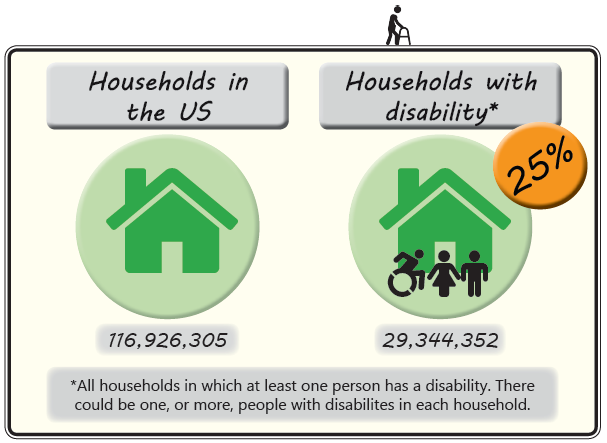Recognizing people with disabilities in the COVID-19 pandemic
April 3, 2020
Understanding the needs of a community is imperative to effectively plan for any type of emergency response, be it natural disaster or a pandemic. As people around the world are dealing with the COVID-19 pandemic, the needs of people with disabilities should not be overlooked or go unaddressed as members of those communities. To assess the impact of COVID on people with disabilities and their needs, it’s important to understand the prevalence of disability by the functional limitations of people living with disabilities experience in their communities.
According to the American Community Survey, about 41 million, or 13%, of Americans have at least one type of disability (ACS 2015). The vast majority (38 million) live in households with other people and a significant number of people with disabilities live in group quarters, which includes dormitories, nursing homes, and prisons.
Approximately 78 million people without disabilities live in households with a member who experiences a disability. This means that nearly 25% of the US population lives in a household with a member with a disability.
(See Prevalence of Disability: Individual and Household Context for more about this research).

Text description: icon of a green house in a circle with this text: Households in the US = 116,926,305. Same green house in a circle icon with three figures, one using a wheelchair, with this text: Households with disability* = 29,344,352, or 25%. *All households in which at least one person has a disability. There could be one, or more, people with disabilities in each household. There is a box around the graphic, and on top of the frame is a small figure using a walker as a mobility aid.
Impairment types
RTC:Rural researchers use data from the ACS to explore how people with disabilities participate in their rural communities. However, the ACS data does not directly measure disability. Instead, it uses questions related to difficulty and functional impairment to identify individuals who may experience a disability. The ACS asks six questions that ask people to identify if they have the following impairment types:
- Hearing difficulty: deaf or having serious difficulty hearing (all ages)
- Vision difficulty: blind or having serious difficulty seeing, even when wearing glasses (all ages)
- Cognitive difficulty: because of a physical, mental, or emotional problem, having difficulty remembering, concentrating, or making decisions (ages 5+)
- Ambulatory (i.e. mobility) difficulty: having serious difficulty walking or climbing stairs (ages 5+)
- Self-care difficulty: having difficulty bathing or dressing (ages 5+)
- Independent living difficulty: because of a physical, mental, or emotional problem, having difficulty doing errands alone such as visiting a doctor’s office or shopping (ages 18+)
Disability Counts
We have created national and state-level maps that show this impairment data at the county level. You can view those maps on the National and State maps pages.
We have also created the Disability Data Lookup Tool, an accessible, online tool that allows you to look up the most recent county-level disability estimates from the ACS. This tool will provide you with a table that includes population estimates and margins of error, disability rates, and rural-urban classification. You can also download the full dataset for all counties in all states.
Knowing the rates of different types of impairments experienced by people in a specific place is important, as it can inform what planning, resources, and services people with disabilities need during a natural disaster or pandemic.
Disability-specific COVID-19 Resources
We have compiled a list of resources to help support people with disabilities during the pandemic. These lists are not exhaustive, but are intended to be a starting place. We will continue to share relevant and useful resources as we find them.
- RTC:Rural COVID-19 Resources
- Rural Institute COVID-19 Resources for People with Disabilities
- Montana Disability & Health Program COVID-19 Information and Resources
How has COVID-19 impacted you and your rural community?
Data is important, but it doesn’t tell the whole story. We need to be aware of, and learn from, the real-life situations people with disabilities are experiencing during the pandemic. Pairing stories with data will allow us to further assist planning, preparedness, and action.
Please continue to follow us as we share more information about recognizing and including people with disabilities in the efforts to address COVID-19.
